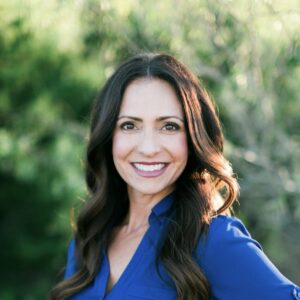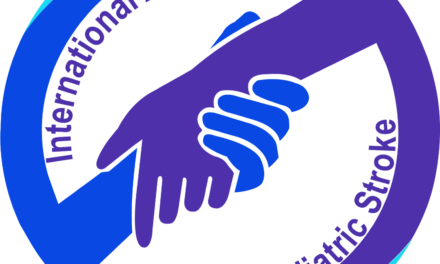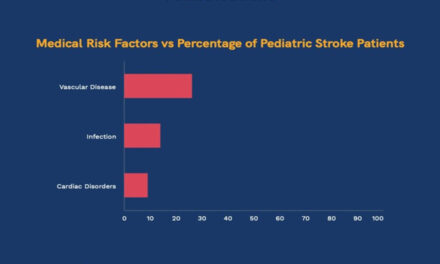It was our first ski trip as a family of five when our lives were turned upside down. On the first morning of our vacation, I immediately noticed slight changes in my two-year-old daughter, Adalee. Her smile looked different, and part of her face was not moving the way it normally did. As the day progressed, I observed subtle differences in Adalee’s lack of speech and the way her right leg began to dip as she walked. My mother’s intuition told me something was very wrong with my child.
 That evening, my husband and I found ourselves in the pediatric intensive care unit where we were informed Adalee suffered an ischemic stroke on the left side of her brain. The team of pediatric neurologists could not find a root cause and characterized her stroke as the “perfect storm”. The term meant that enough factors had come together at just the right time and place to cause her “acute situation”. The good news was Adalee did not have a blood disorder or problem with her organs. However, the storm had left a wake of destruction: Adalee had lost her speech and was paralyzed on the entire right side of her body.
That evening, my husband and I found ourselves in the pediatric intensive care unit where we were informed Adalee suffered an ischemic stroke on the left side of her brain. The team of pediatric neurologists could not find a root cause and characterized her stroke as the “perfect storm”. The term meant that enough factors had come together at just the right time and place to cause her “acute situation”. The good news was Adalee did not have a blood disorder or problem with her organs. However, the storm had left a wake of destruction: Adalee had lost her speech and was paralyzed on the entire right side of her body.
Hours after her diagnosis the team of doctors could not predict what life would be like for Adalee, and we did not know if she would ever walk or talk again. My heart grieved what she had lost, but I also felt a resolve: I would do whatever it took for the rest of my life to help Adalee recover to the best of her ability.
Adalee was in the hospital for two weeks, was stabilized, learned to swallow, and began basic therapy to learn to sit up on her own. As Adalee’s advocate, I asked questions, addressed issues, kindly asked the team of pediatric neurologists to explain medical terms, and made it a point to communicate effectively with the team of doctors and therapists. As her mother, I knew it was my job to ensure the best possible outcome for my daughter.
Once Adalee was stabilized, she was transferred to a children’s inpatient rehabilitation facility in Dallas, Texas. Adalee began intensive physical, occupational, and speech therapies. Constraint therapy was implemented to improve the use of her right arm, hand, and fingers. Initially, the plan for Adalee was to stay as an inpatient for eight to twelve weeks. However, after one session of physical therapy she began to run and due to her rapid progress, she was released after four weeks.
occupational, and speech therapies. Constraint therapy was implemented to improve the use of her right arm, hand, and fingers. Initially, the plan for Adalee was to stay as an inpatient for eight to twelve weeks. However, after one session of physical therapy she began to run and due to her rapid progress, she was released after four weeks.
At home, our new normal consisted of Adalee attending three days of outpatient therapy each week. For the next two and a half years, Adalee would receive physical and occupational therapies to increase the strength of her right leg, foot, hand, and fingers. Her speech returned quickly, and her determination to keep up with her older siblings led to her physical recovery.
Although Adalee was able to live as a normal child, I anticipated she might face challenges once she was in school. After three years of doctors’ visits and discussing research findings with her neurologist, I learned that the language part of Adalee’s brain had been impacted by her stroke when she temporarily lost her ability to speak. Even though her speech returned, her neurons had grown new pathways to reconnect in the language part of her brain where we process reading.
During Adalee’s pre-school years, I worked with her on letters and numbers using workbooks, games, and puzzles which exercised her memory. Once Adalee was six years old and in kindergarten, I noticed she was not reading at her age level. I discussed this with her neurologist who then ordered a psychological evaluation to determine if she had a reading disability, but a diagnosis was not found. Adalee was intelligent and had learned the art of compensating for her weaknesses. Her struggle to read flew under the radar and was not apparent to her teachers or diagnosticians.
As her mother, it was my job to communicate with her teachers regarding her medical history. By the time Adalee was in the third-grade schoolwork became more challenging. Adalee displayed a few symptoms of dyslexia, but reading specialists found that was not the correct diagnosis. Adalee did not fit the mold of defined learning disabilities. She was not born with a delay or issue. Her brain had suffered trauma and was in a process of recovery. She was diagnosed with a reading deficiency that was unlike that of the other students in their program. With her new treatment plan and six-week reading program, Adalee improved tremendously and could catch up to read on grade level. For the next two years, her elementary school psychologist, reading, and math specialists would use the specialized diagnosis to create a customized program for Adalee where she worked on specific academic exercises each day. Allowing extra time to complete her work, repetition, and teaching Adalee how to use tools and accommodations taught her brain how to process information. Working an hour or two with specialists each day offered effective results.
Adalee’s life as a seventh grader is now spent singing in choir, playing volleyball, running track, and doing all the things we were told she would never be able to do. Life has moved on, but I hold dear the lessons we learned as we weathered the “Perfect Storm”.
Trust Your Instincts: Never ignore your intuition as a parent. You know your child better than anyone else and often notice subtle changes before others. If something does not feel right, keep speaking up, even if it takes time to be heard.
You are Your Child’s Greatest Advocate: Never be intimidated to ask questions. If you do not understand the medical terms, ask again. Complex conditions often come with complex explanations. Ask for things to be explained in plain language, and do not hesitate to revisit conversations until they make sense to you.
Be Proactive: Address the issues, and encourage coordination between doctors, therapists, and educators to ensure a team approach to effectively provide solutions for your child.
The journey of recovery was hard work, and in the process, we learned the greatest lesson was to teach Adalee how to be her own advocate. Our children watch how we respond and learn from our actions. Adalee works hard, is strong, and has weathered a storm most people never have to face. Adalee is a survivor, an overcomer, and has allowed me to use her story to encourage others. One day I believe she will share her own story about how she overcame her “Perfect Storm”.
About the Author

Sarah Nelson
Sarah Nelson is the mother of a stroke survivor who lives with her husband and three children in Waco, Texas. Sarah is the owner of Waco Moms, the top digital resource for parents in the greater Waco area and is the author of the book A Perfect Storm. Sarah is a speaker to women’s and crisis groups on how to advocate for your children and increases awareness and education of symptoms of pediatric strokes.
Graphics: Sarah Nelson
Medical Editors: Mesha Martinez
Junior Editor: Natalie Mahgerefteh





